Influence of Protective Factors on Child Wellbeing Essay, HCS321
VerifiedAdded on 2022/08/16
|8
|2855
|12
Essay
AI Summary
This essay, written for the HCS321 course, delves into the significant role of protective factors in the health and wellbeing of children and young people. It examines how these factors, encompassing family environment, social connections, and community support, mitigate risks and promote positive development. The essay emphasizes the importance of parental resilience, social connections, concrete support, child development knowledge, and effective parenting. It highlights the influence of nurturing relationships, emotional competence, and socioeconomic factors on child outcomes. The research explores the adverse effects of poverty, mental health challenges, and social isolation and underscores the need for proactive interventions. The essay concludes by stressing the need for a holistic approach that involves families, communities, and organizations to foster a supportive environment for children's growth and success.
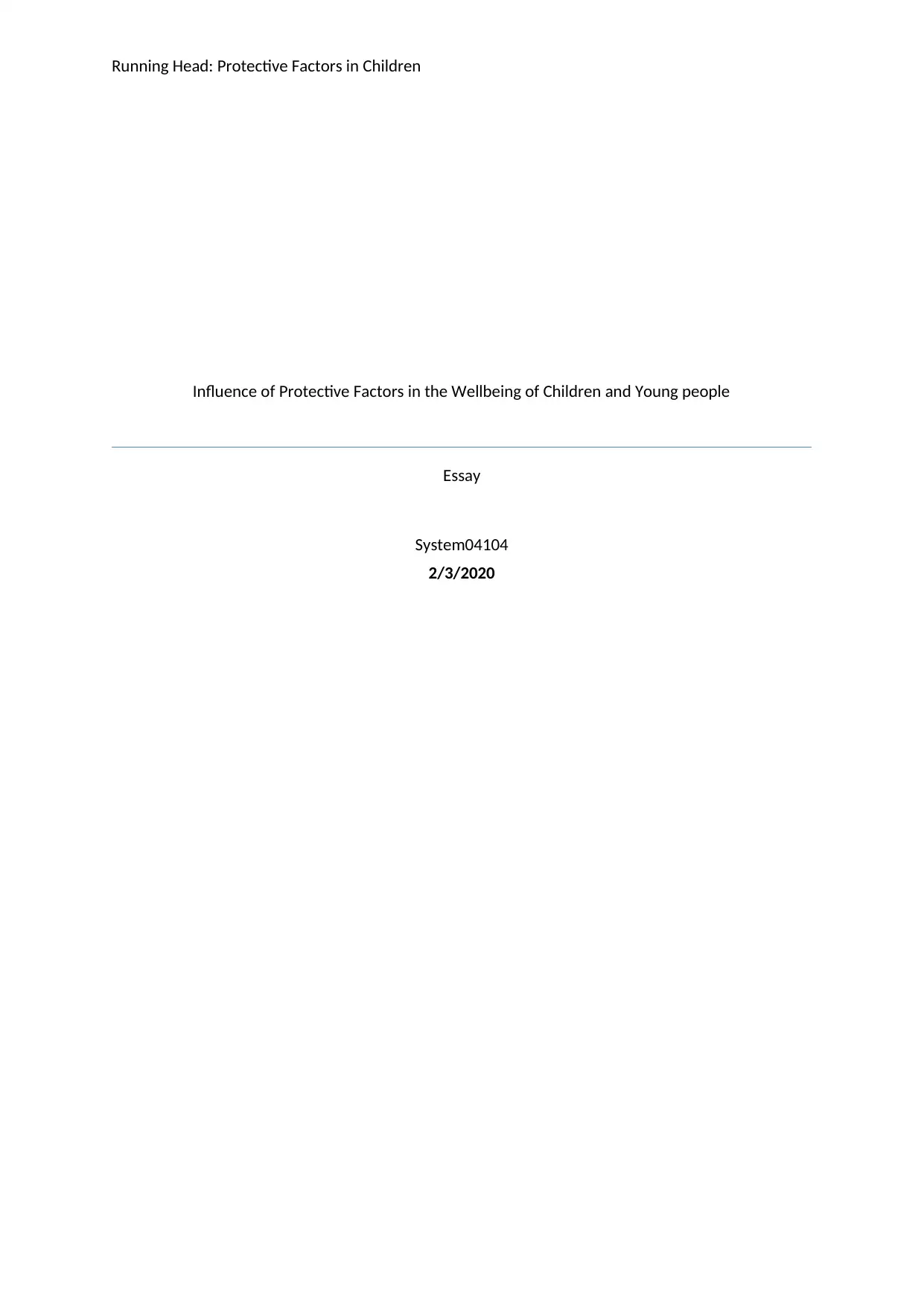
Running Head: Protective Factors in Children
Influence of Protective Factors in the Wellbeing of Children and Young people
Essay
System04104
2/3/2020
Influence of Protective Factors in the Wellbeing of Children and Young people
Essay
System04104
2/3/2020
Paraphrase This Document
Need a fresh take? Get an instant paraphrase of this document with our AI Paraphraser
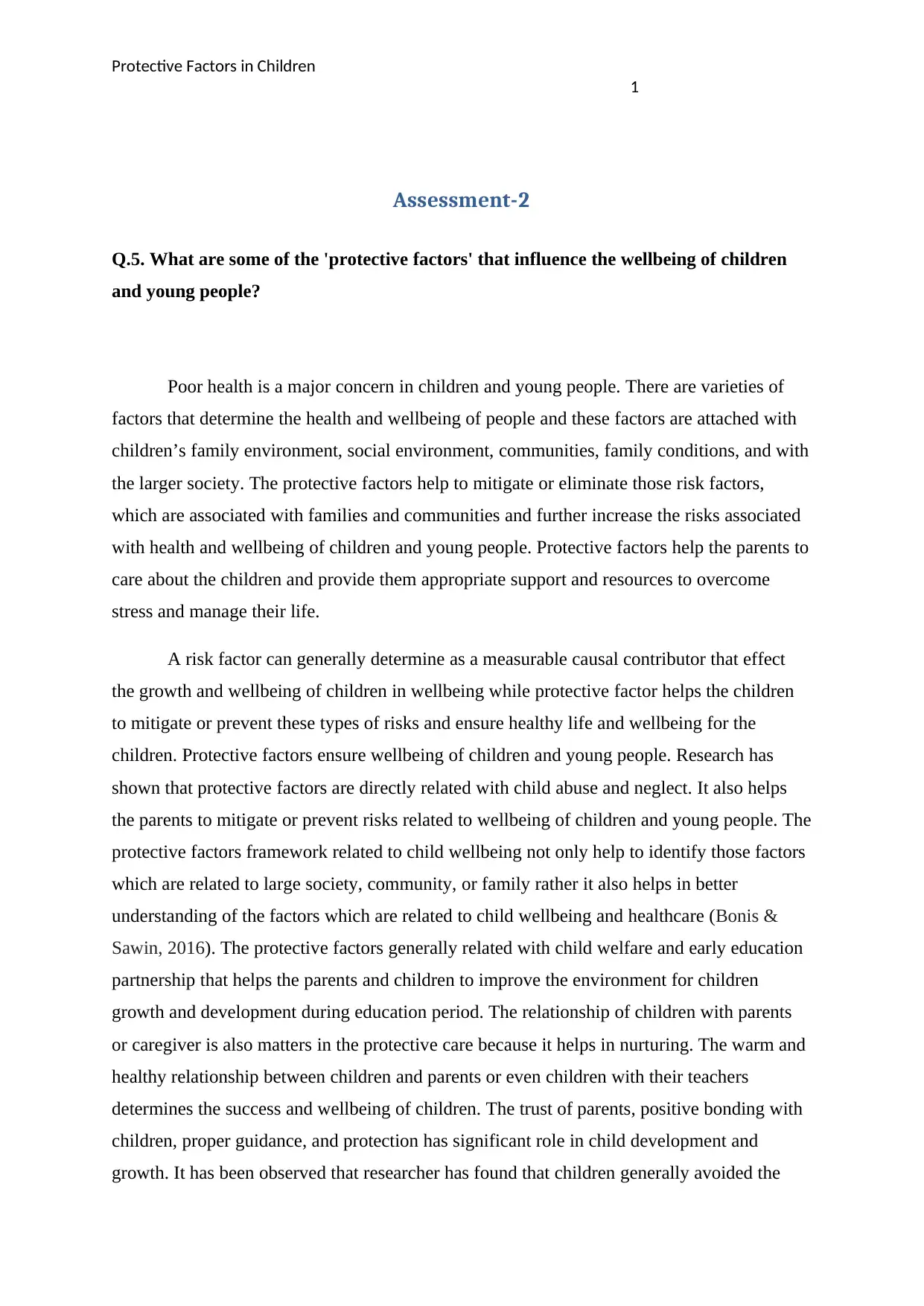
Protective Factors in Children
1
Assessment-2
Q.5. What are some of the 'protective factors' that influence the wellbeing of children
and young people?
Poor health is a major concern in children and young people. There are varieties of
factors that determine the health and wellbeing of people and these factors are attached with
children’s family environment, social environment, communities, family conditions, and with
the larger society. The protective factors help to mitigate or eliminate those risk factors,
which are associated with families and communities and further increase the risks associated
with health and wellbeing of children and young people. Protective factors help the parents to
care about the children and provide them appropriate support and resources to overcome
stress and manage their life.
A risk factor can generally determine as a measurable causal contributor that effect
the growth and wellbeing of children in wellbeing while protective factor helps the children
to mitigate or prevent these types of risks and ensure healthy life and wellbeing for the
children. Protective factors ensure wellbeing of children and young people. Research has
shown that protective factors are directly related with child abuse and neglect. It also helps
the parents to mitigate or prevent risks related to wellbeing of children and young people. The
protective factors framework related to child wellbeing not only help to identify those factors
which are related to large society, community, or family rather it also helps in better
understanding of the factors which are related to child wellbeing and healthcare (Bonis &
Sawin, 2016). The protective factors generally related with child welfare and early education
partnership that helps the parents and children to improve the environment for children
growth and development during education period. The relationship of children with parents
or caregiver is also matters in the protective care because it helps in nurturing. The warm and
healthy relationship between children and parents or even children with their teachers
determines the success and wellbeing of children. The trust of parents, positive bonding with
children, proper guidance, and protection has significant role in child development and
growth. It has been observed that researcher has found that children generally avoided the
1
Assessment-2
Q.5. What are some of the 'protective factors' that influence the wellbeing of children
and young people?
Poor health is a major concern in children and young people. There are varieties of
factors that determine the health and wellbeing of people and these factors are attached with
children’s family environment, social environment, communities, family conditions, and with
the larger society. The protective factors help to mitigate or eliminate those risk factors,
which are associated with families and communities and further increase the risks associated
with health and wellbeing of children and young people. Protective factors help the parents to
care about the children and provide them appropriate support and resources to overcome
stress and manage their life.
A risk factor can generally determine as a measurable causal contributor that effect
the growth and wellbeing of children in wellbeing while protective factor helps the children
to mitigate or prevent these types of risks and ensure healthy life and wellbeing for the
children. Protective factors ensure wellbeing of children and young people. Research has
shown that protective factors are directly related with child abuse and neglect. It also helps
the parents to mitigate or prevent risks related to wellbeing of children and young people. The
protective factors framework related to child wellbeing not only help to identify those factors
which are related to large society, community, or family rather it also helps in better
understanding of the factors which are related to child wellbeing and healthcare (Bonis &
Sawin, 2016). The protective factors generally related with child welfare and early education
partnership that helps the parents and children to improve the environment for children
growth and development during education period. The relationship of children with parents
or caregiver is also matters in the protective care because it helps in nurturing. The warm and
healthy relationship between children and parents or even children with their teachers
determines the success and wellbeing of children. The trust of parents, positive bonding with
children, proper guidance, and protection has significant role in child development and
growth. It has been observed that researcher has found that children generally avoided the
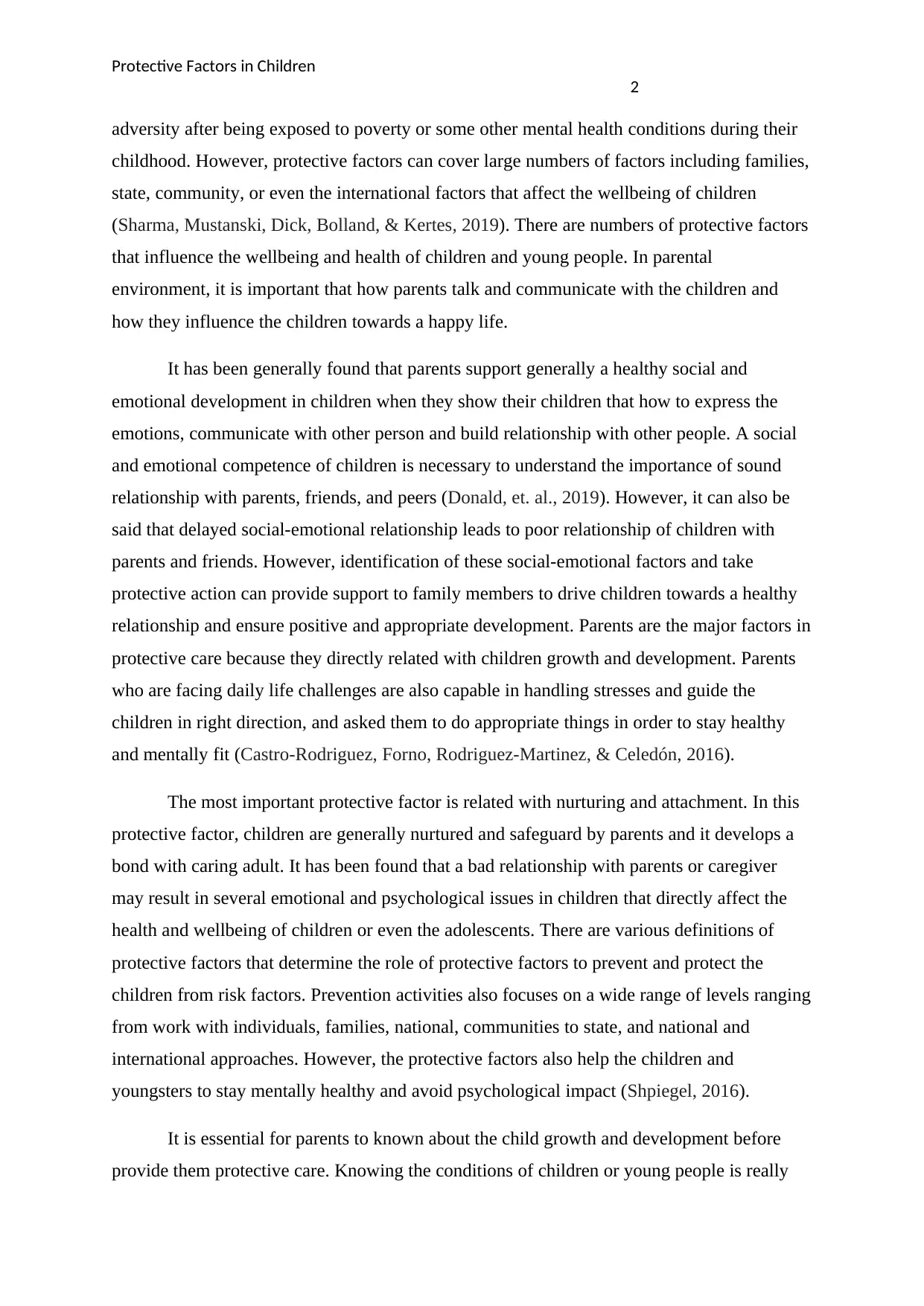
Protective Factors in Children
2
adversity after being exposed to poverty or some other mental health conditions during their
childhood. However, protective factors can cover large numbers of factors including families,
state, community, or even the international factors that affect the wellbeing of children
(Sharma, Mustanski, Dick, Bolland, & Kertes, 2019). There are numbers of protective factors
that influence the wellbeing and health of children and young people. In parental
environment, it is important that how parents talk and communicate with the children and
how they influence the children towards a happy life.
It has been generally found that parents support generally a healthy social and
emotional development in children when they show their children that how to express the
emotions, communicate with other person and build relationship with other people. A social
and emotional competence of children is necessary to understand the importance of sound
relationship with parents, friends, and peers (Donald, et. al., 2019). However, it can also be
said that delayed social-emotional relationship leads to poor relationship of children with
parents and friends. However, identification of these social-emotional factors and take
protective action can provide support to family members to drive children towards a healthy
relationship and ensure positive and appropriate development. Parents are the major factors in
protective care because they directly related with children growth and development. Parents
who are facing daily life challenges are also capable in handling stresses and guide the
children in right direction, and asked them to do appropriate things in order to stay healthy
and mentally fit (Castro-Rodriguez, Forno, Rodriguez-Martinez, & Celedón, 2016).
The most important protective factor is related with nurturing and attachment. In this
protective factor, children are generally nurtured and safeguard by parents and it develops a
bond with caring adult. It has been found that a bad relationship with parents or caregiver
may result in several emotional and psychological issues in children that directly affect the
health and wellbeing of children or even the adolescents. There are various definitions of
protective factors that determine the role of protective factors to prevent and protect the
children from risk factors. Prevention activities also focuses on a wide range of levels ranging
from work with individuals, families, national, communities to state, and national and
international approaches. However, the protective factors also help the children and
youngsters to stay mentally healthy and avoid psychological impact (Shpiegel, 2016).
It is essential for parents to known about the child growth and development before
provide them protective care. Knowing the conditions of children or young people is really
2
adversity after being exposed to poverty or some other mental health conditions during their
childhood. However, protective factors can cover large numbers of factors including families,
state, community, or even the international factors that affect the wellbeing of children
(Sharma, Mustanski, Dick, Bolland, & Kertes, 2019). There are numbers of protective factors
that influence the wellbeing and health of children and young people. In parental
environment, it is important that how parents talk and communicate with the children and
how they influence the children towards a happy life.
It has been generally found that parents support generally a healthy social and
emotional development in children when they show their children that how to express the
emotions, communicate with other person and build relationship with other people. A social
and emotional competence of children is necessary to understand the importance of sound
relationship with parents, friends, and peers (Donald, et. al., 2019). However, it can also be
said that delayed social-emotional relationship leads to poor relationship of children with
parents and friends. However, identification of these social-emotional factors and take
protective action can provide support to family members to drive children towards a healthy
relationship and ensure positive and appropriate development. Parents are the major factors in
protective care because they directly related with children growth and development. Parents
who are facing daily life challenges are also capable in handling stresses and guide the
children in right direction, and asked them to do appropriate things in order to stay healthy
and mentally fit (Castro-Rodriguez, Forno, Rodriguez-Martinez, & Celedón, 2016).
The most important protective factor is related with nurturing and attachment. In this
protective factor, children are generally nurtured and safeguard by parents and it develops a
bond with caring adult. It has been found that a bad relationship with parents or caregiver
may result in several emotional and psychological issues in children that directly affect the
health and wellbeing of children or even the adolescents. There are various definitions of
protective factors that determine the role of protective factors to prevent and protect the
children from risk factors. Prevention activities also focuses on a wide range of levels ranging
from work with individuals, families, national, communities to state, and national and
international approaches. However, the protective factors also help the children and
youngsters to stay mentally healthy and avoid psychological impact (Shpiegel, 2016).
It is essential for parents to known about the child growth and development before
provide them protective care. Knowing the conditions of children or young people is really
⊘ This is a preview!⊘
Do you want full access?
Subscribe today to unlock all pages.

Trusted by 1+ million students worldwide
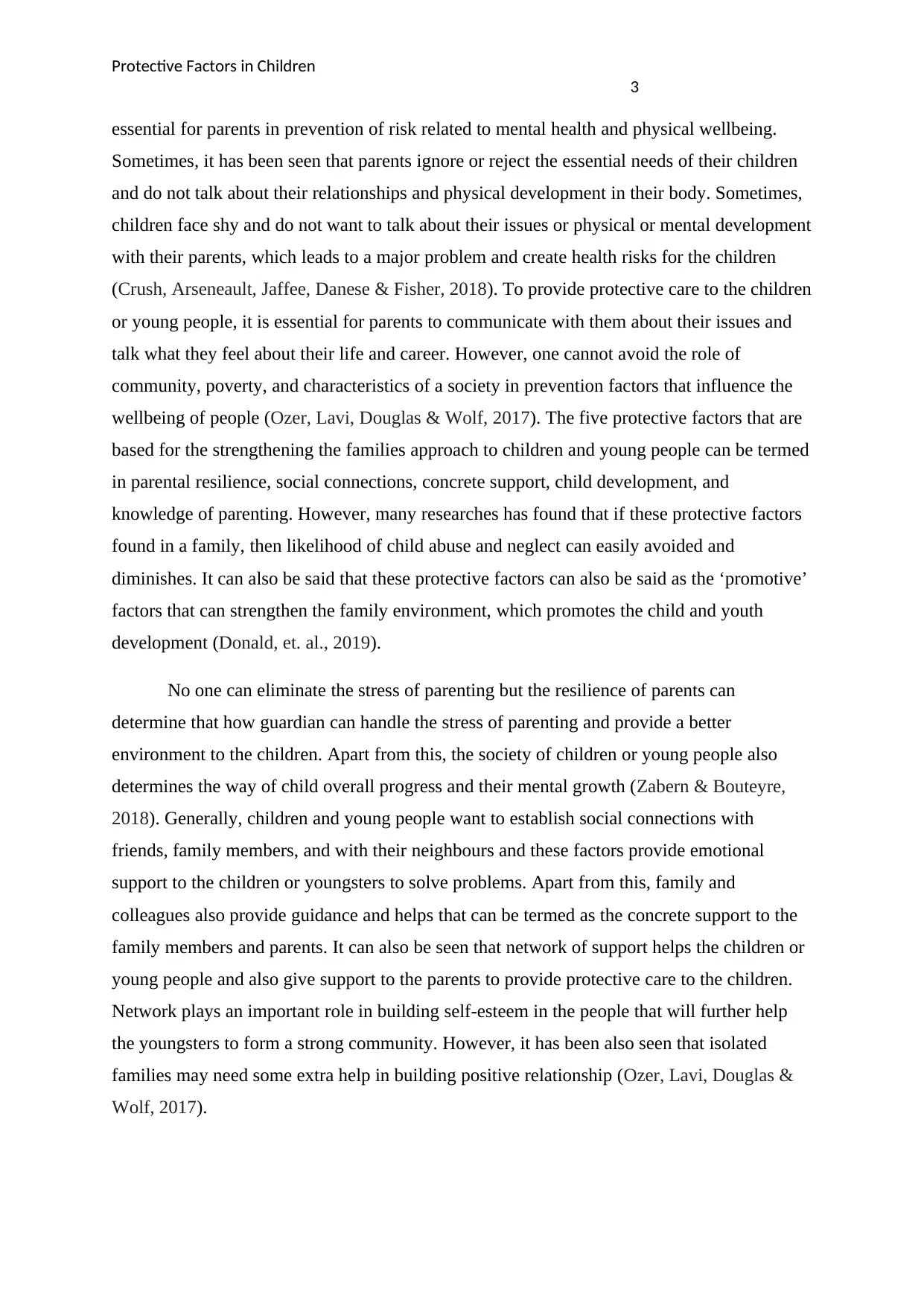
Protective Factors in Children
3
essential for parents in prevention of risk related to mental health and physical wellbeing.
Sometimes, it has been seen that parents ignore or reject the essential needs of their children
and do not talk about their relationships and physical development in their body. Sometimes,
children face shy and do not want to talk about their issues or physical or mental development
with their parents, which leads to a major problem and create health risks for the children
(Crush, Arseneault, Jaffee, Danese & Fisher, 2018). To provide protective care to the children
or young people, it is essential for parents to communicate with them about their issues and
talk what they feel about their life and career. However, one cannot avoid the role of
community, poverty, and characteristics of a society in prevention factors that influence the
wellbeing of people (Ozer, Lavi, Douglas & Wolf, 2017). The five protective factors that are
based for the strengthening the families approach to children and young people can be termed
in parental resilience, social connections, concrete support, child development, and
knowledge of parenting. However, many researches has found that if these protective factors
found in a family, then likelihood of child abuse and neglect can easily avoided and
diminishes. It can also be said that these protective factors can also be said as the ‘promotive’
factors that can strengthen the family environment, which promotes the child and youth
development (Donald, et. al., 2019).
No one can eliminate the stress of parenting but the resilience of parents can
determine that how guardian can handle the stress of parenting and provide a better
environment to the children. Apart from this, the society of children or young people also
determines the way of child overall progress and their mental growth (Zabern & Bouteyre,
2018). Generally, children and young people want to establish social connections with
friends, family members, and with their neighbours and these factors provide emotional
support to the children or youngsters to solve problems. Apart from this, family and
colleagues also provide guidance and helps that can be termed as the concrete support to the
family members and parents. It can also be seen that network of support helps the children or
young people and also give support to the parents to provide protective care to the children.
Network plays an important role in building self-esteem in the people that will further help
the youngsters to form a strong community. However, it has been also seen that isolated
families may need some extra help in building positive relationship (Ozer, Lavi, Douglas &
Wolf, 2017).
3
essential for parents in prevention of risk related to mental health and physical wellbeing.
Sometimes, it has been seen that parents ignore or reject the essential needs of their children
and do not talk about their relationships and physical development in their body. Sometimes,
children face shy and do not want to talk about their issues or physical or mental development
with their parents, which leads to a major problem and create health risks for the children
(Crush, Arseneault, Jaffee, Danese & Fisher, 2018). To provide protective care to the children
or young people, it is essential for parents to communicate with them about their issues and
talk what they feel about their life and career. However, one cannot avoid the role of
community, poverty, and characteristics of a society in prevention factors that influence the
wellbeing of people (Ozer, Lavi, Douglas & Wolf, 2017). The five protective factors that are
based for the strengthening the families approach to children and young people can be termed
in parental resilience, social connections, concrete support, child development, and
knowledge of parenting. However, many researches has found that if these protective factors
found in a family, then likelihood of child abuse and neglect can easily avoided and
diminishes. It can also be said that these protective factors can also be said as the ‘promotive’
factors that can strengthen the family environment, which promotes the child and youth
development (Donald, et. al., 2019).
No one can eliminate the stress of parenting but the resilience of parents can
determine that how guardian can handle the stress of parenting and provide a better
environment to the children. Apart from this, the society of children or young people also
determines the way of child overall progress and their mental growth (Zabern & Bouteyre,
2018). Generally, children and young people want to establish social connections with
friends, family members, and with their neighbours and these factors provide emotional
support to the children or youngsters to solve problems. Apart from this, family and
colleagues also provide guidance and helps that can be termed as the concrete support to the
family members and parents. It can also be seen that network of support helps the children or
young people and also give support to the parents to provide protective care to the children.
Network plays an important role in building self-esteem in the people that will further help
the youngsters to form a strong community. However, it has been also seen that isolated
families may need some extra help in building positive relationship (Ozer, Lavi, Douglas &
Wolf, 2017).
Paraphrase This Document
Need a fresh take? Get an instant paraphrase of this document with our AI Paraphraser
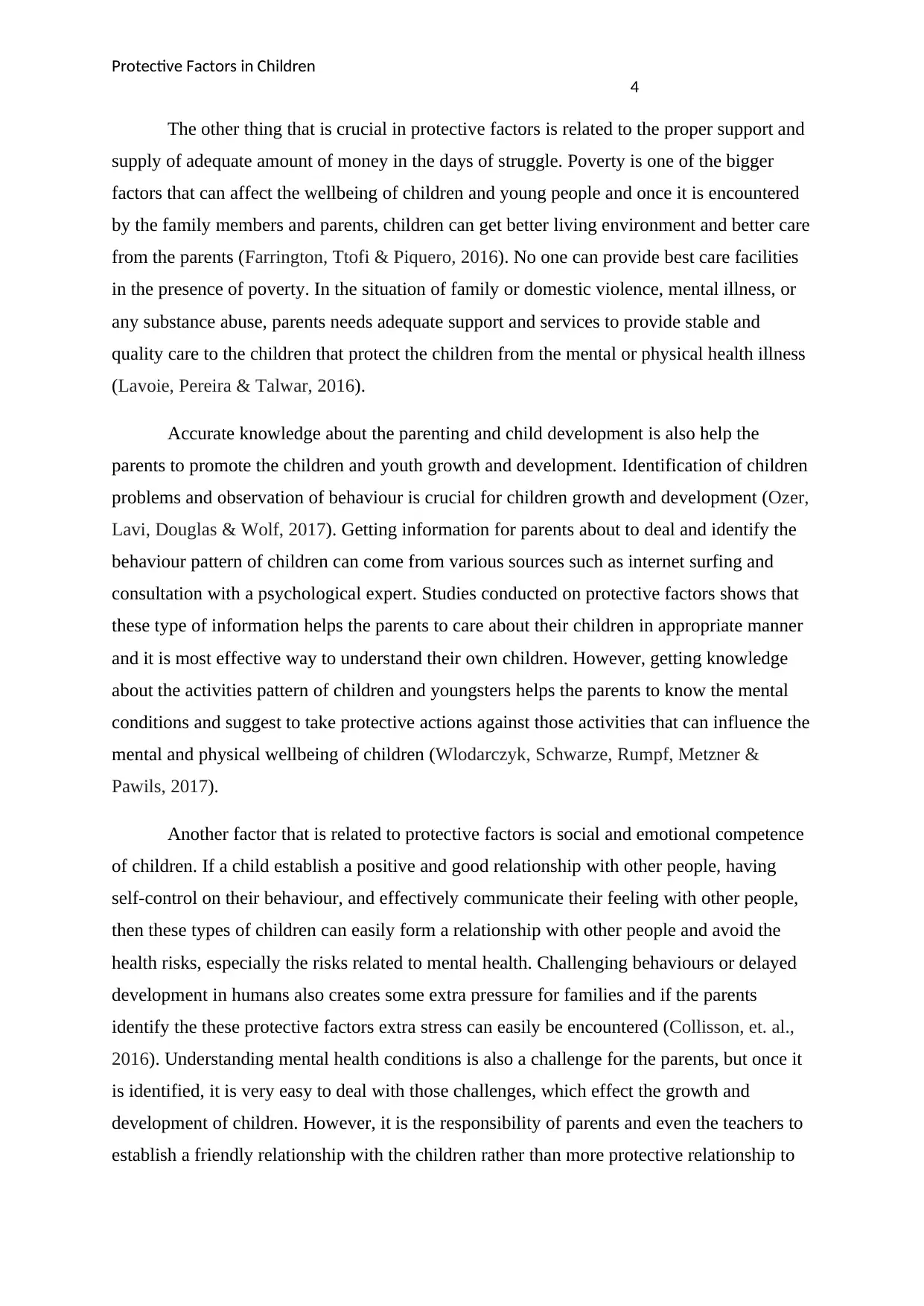
Protective Factors in Children
4
The other thing that is crucial in protective factors is related to the proper support and
supply of adequate amount of money in the days of struggle. Poverty is one of the bigger
factors that can affect the wellbeing of children and young people and once it is encountered
by the family members and parents, children can get better living environment and better care
from the parents (Farrington, Ttofi & Piquero, 2016). No one can provide best care facilities
in the presence of poverty. In the situation of family or domestic violence, mental illness, or
any substance abuse, parents needs adequate support and services to provide stable and
quality care to the children that protect the children from the mental or physical health illness
(Lavoie, Pereira & Talwar, 2016).
Accurate knowledge about the parenting and child development is also help the
parents to promote the children and youth growth and development. Identification of children
problems and observation of behaviour is crucial for children growth and development (Ozer,
Lavi, Douglas & Wolf, 2017). Getting information for parents about to deal and identify the
behaviour pattern of children can come from various sources such as internet surfing and
consultation with a psychological expert. Studies conducted on protective factors shows that
these type of information helps the parents to care about their children in appropriate manner
and it is most effective way to understand their own children. However, getting knowledge
about the activities pattern of children and youngsters helps the parents to know the mental
conditions and suggest to take protective actions against those activities that can influence the
mental and physical wellbeing of children (Wlodarczyk, Schwarze, Rumpf, Metzner &
Pawils, 2017).
Another factor that is related to protective factors is social and emotional competence
of children. If a child establish a positive and good relationship with other people, having
self-control on their behaviour, and effectively communicate their feeling with other people,
then these types of children can easily form a relationship with other people and avoid the
health risks, especially the risks related to mental health. Challenging behaviours or delayed
development in humans also creates some extra pressure for families and if the parents
identify the these protective factors extra stress can easily be encountered (Collisson, et. al.,
2016). Understanding mental health conditions is also a challenge for the parents, but once it
is identified, it is very easy to deal with those challenges, which effect the growth and
development of children. However, it is the responsibility of parents and even the teachers to
establish a friendly relationship with the children rather than more protective relationship to
4
The other thing that is crucial in protective factors is related to the proper support and
supply of adequate amount of money in the days of struggle. Poverty is one of the bigger
factors that can affect the wellbeing of children and young people and once it is encountered
by the family members and parents, children can get better living environment and better care
from the parents (Farrington, Ttofi & Piquero, 2016). No one can provide best care facilities
in the presence of poverty. In the situation of family or domestic violence, mental illness, or
any substance abuse, parents needs adequate support and services to provide stable and
quality care to the children that protect the children from the mental or physical health illness
(Lavoie, Pereira & Talwar, 2016).
Accurate knowledge about the parenting and child development is also help the
parents to promote the children and youth growth and development. Identification of children
problems and observation of behaviour is crucial for children growth and development (Ozer,
Lavi, Douglas & Wolf, 2017). Getting information for parents about to deal and identify the
behaviour pattern of children can come from various sources such as internet surfing and
consultation with a psychological expert. Studies conducted on protective factors shows that
these type of information helps the parents to care about their children in appropriate manner
and it is most effective way to understand their own children. However, getting knowledge
about the activities pattern of children and youngsters helps the parents to know the mental
conditions and suggest to take protective actions against those activities that can influence the
mental and physical wellbeing of children (Wlodarczyk, Schwarze, Rumpf, Metzner &
Pawils, 2017).
Another factor that is related to protective factors is social and emotional competence
of children. If a child establish a positive and good relationship with other people, having
self-control on their behaviour, and effectively communicate their feeling with other people,
then these types of children can easily form a relationship with other people and avoid the
health risks, especially the risks related to mental health. Challenging behaviours or delayed
development in humans also creates some extra pressure for families and if the parents
identify the these protective factors extra stress can easily be encountered (Collisson, et. al.,
2016). Understanding mental health conditions is also a challenge for the parents, but once it
is identified, it is very easy to deal with those challenges, which effect the growth and
development of children. However, it is the responsibility of parents and even the teachers to
establish a friendly relationship with the children rather than more protective relationship to
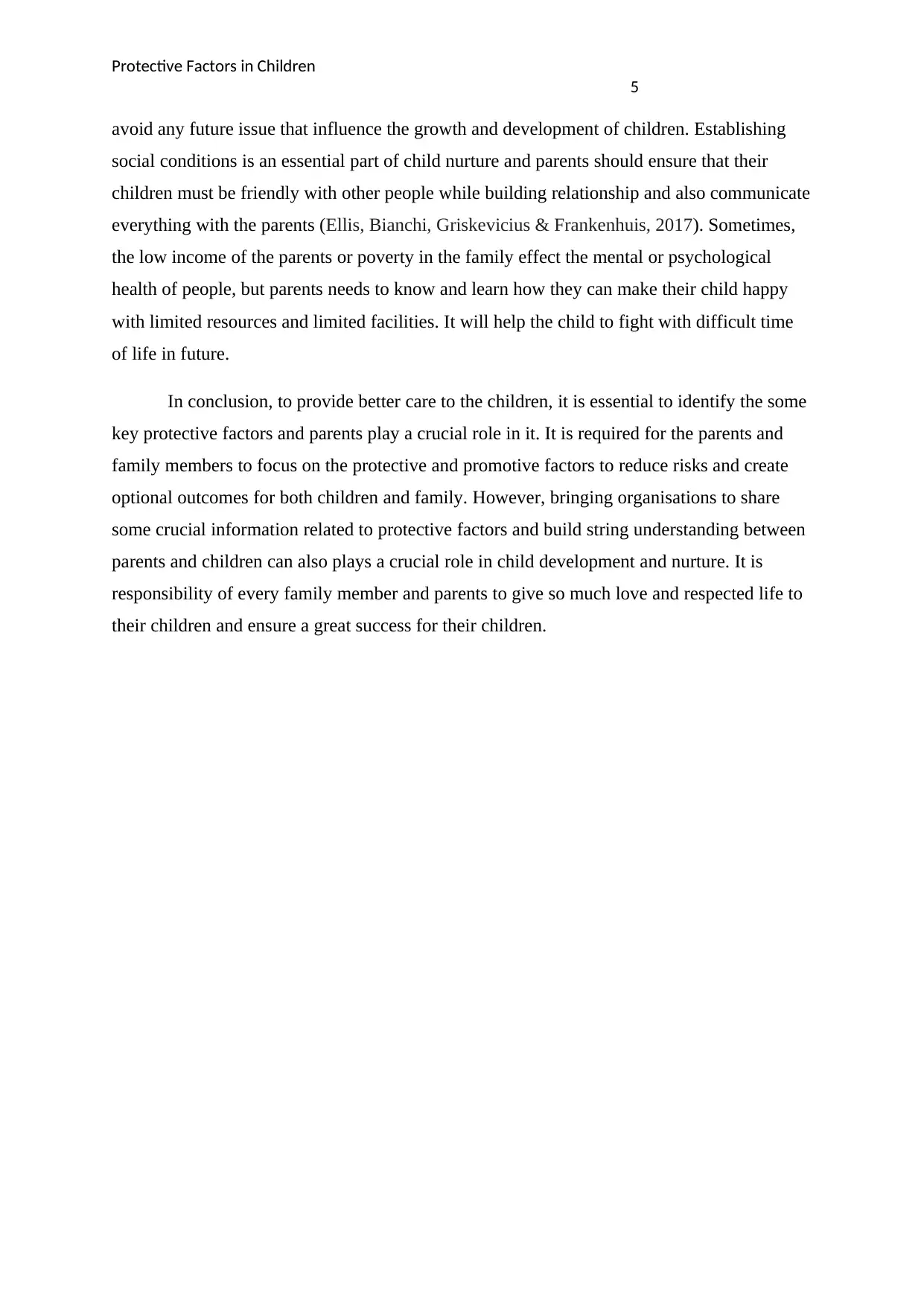
Protective Factors in Children
5
avoid any future issue that influence the growth and development of children. Establishing
social conditions is an essential part of child nurture and parents should ensure that their
children must be friendly with other people while building relationship and also communicate
everything with the parents (Ellis, Bianchi, Griskevicius & Frankenhuis, 2017). Sometimes,
the low income of the parents or poverty in the family effect the mental or psychological
health of people, but parents needs to know and learn how they can make their child happy
with limited resources and limited facilities. It will help the child to fight with difficult time
of life in future.
In conclusion, to provide better care to the children, it is essential to identify the some
key protective factors and parents play a crucial role in it. It is required for the parents and
family members to focus on the protective and promotive factors to reduce risks and create
optional outcomes for both children and family. However, bringing organisations to share
some crucial information related to protective factors and build string understanding between
parents and children can also plays a crucial role in child development and nurture. It is
responsibility of every family member and parents to give so much love and respected life to
their children and ensure a great success for their children.
5
avoid any future issue that influence the growth and development of children. Establishing
social conditions is an essential part of child nurture and parents should ensure that their
children must be friendly with other people while building relationship and also communicate
everything with the parents (Ellis, Bianchi, Griskevicius & Frankenhuis, 2017). Sometimes,
the low income of the parents or poverty in the family effect the mental or psychological
health of people, but parents needs to know and learn how they can make their child happy
with limited resources and limited facilities. It will help the child to fight with difficult time
of life in future.
In conclusion, to provide better care to the children, it is essential to identify the some
key protective factors and parents play a crucial role in it. It is required for the parents and
family members to focus on the protective and promotive factors to reduce risks and create
optional outcomes for both children and family. However, bringing organisations to share
some crucial information related to protective factors and build string understanding between
parents and children can also plays a crucial role in child development and nurture. It is
responsibility of every family member and parents to give so much love and respected life to
their children and ensure a great success for their children.
⊘ This is a preview!⊘
Do you want full access?
Subscribe today to unlock all pages.

Trusted by 1+ million students worldwide
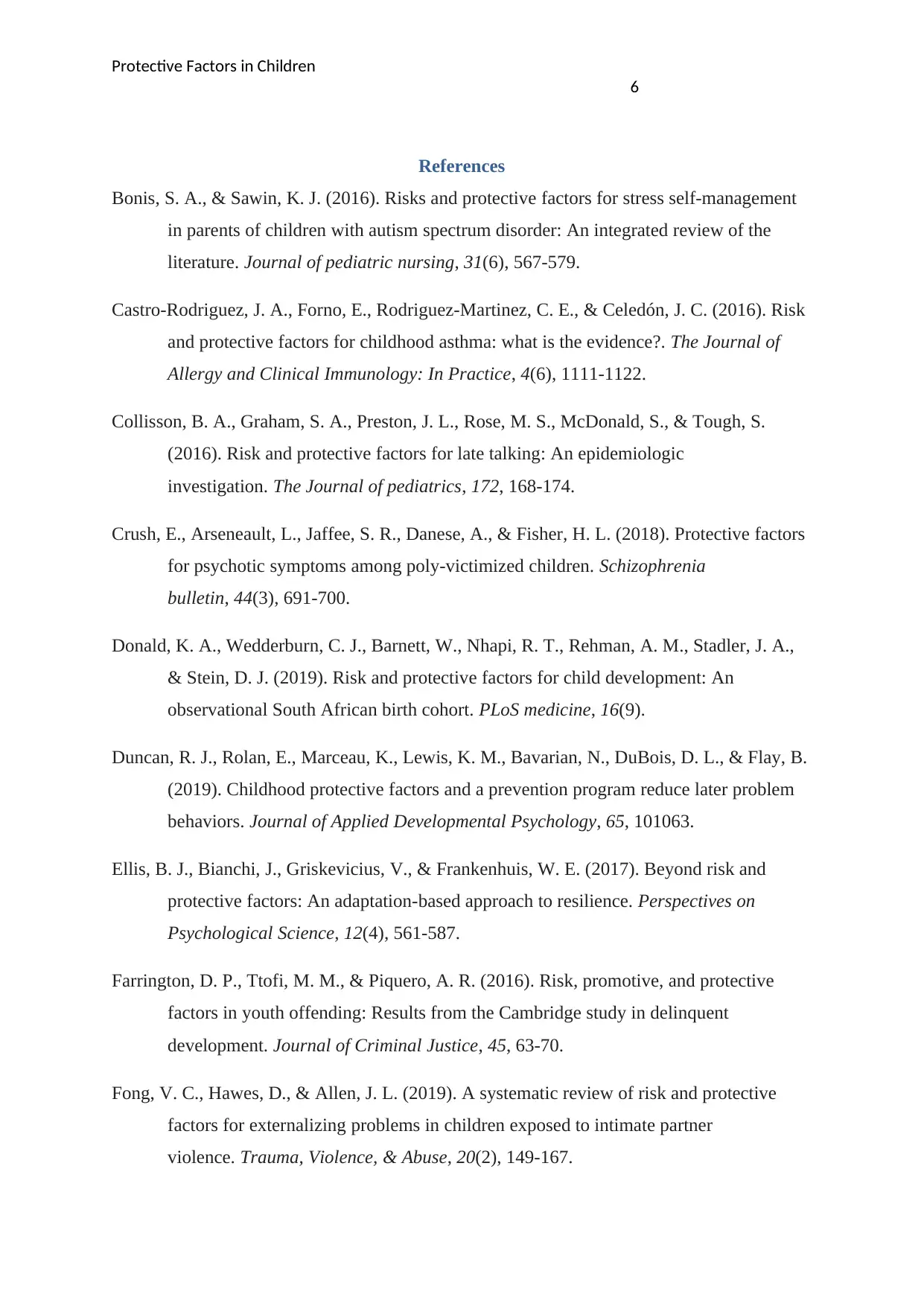
Protective Factors in Children
6
References
Bonis, S. A., & Sawin, K. J. (2016). Risks and protective factors for stress self-management
in parents of children with autism spectrum disorder: An integrated review of the
literature. Journal of pediatric nursing, 31(6), 567-579.
Castro-Rodriguez, J. A., Forno, E., Rodriguez-Martinez, C. E., & Celedón, J. C. (2016). Risk
and protective factors for childhood asthma: what is the evidence?. The Journal of
Allergy and Clinical Immunology: In Practice, 4(6), 1111-1122.
Collisson, B. A., Graham, S. A., Preston, J. L., Rose, M. S., McDonald, S., & Tough, S.
(2016). Risk and protective factors for late talking: An epidemiologic
investigation. The Journal of pediatrics, 172, 168-174.
Crush, E., Arseneault, L., Jaffee, S. R., Danese, A., & Fisher, H. L. (2018). Protective factors
for psychotic symptoms among poly-victimized children. Schizophrenia
bulletin, 44(3), 691-700.
Donald, K. A., Wedderburn, C. J., Barnett, W., Nhapi, R. T., Rehman, A. M., Stadler, J. A.,
& Stein, D. J. (2019). Risk and protective factors for child development: An
observational South African birth cohort. PLoS medicine, 16(9).
Duncan, R. J., Rolan, E., Marceau, K., Lewis, K. M., Bavarian, N., DuBois, D. L., & Flay, B.
(2019). Childhood protective factors and a prevention program reduce later problem
behaviors. Journal of Applied Developmental Psychology, 65, 101063.
Ellis, B. J., Bianchi, J., Griskevicius, V., & Frankenhuis, W. E. (2017). Beyond risk and
protective factors: An adaptation-based approach to resilience. Perspectives on
Psychological Science, 12(4), 561-587.
Farrington, D. P., Ttofi, M. M., & Piquero, A. R. (2016). Risk, promotive, and protective
factors in youth offending: Results from the Cambridge study in delinquent
development. Journal of Criminal Justice, 45, 63-70.
Fong, V. C., Hawes, D., & Allen, J. L. (2019). A systematic review of risk and protective
factors for externalizing problems in children exposed to intimate partner
violence. Trauma, Violence, & Abuse, 20(2), 149-167.
6
References
Bonis, S. A., & Sawin, K. J. (2016). Risks and protective factors for stress self-management
in parents of children with autism spectrum disorder: An integrated review of the
literature. Journal of pediatric nursing, 31(6), 567-579.
Castro-Rodriguez, J. A., Forno, E., Rodriguez-Martinez, C. E., & Celedón, J. C. (2016). Risk
and protective factors for childhood asthma: what is the evidence?. The Journal of
Allergy and Clinical Immunology: In Practice, 4(6), 1111-1122.
Collisson, B. A., Graham, S. A., Preston, J. L., Rose, M. S., McDonald, S., & Tough, S.
(2016). Risk and protective factors for late talking: An epidemiologic
investigation. The Journal of pediatrics, 172, 168-174.
Crush, E., Arseneault, L., Jaffee, S. R., Danese, A., & Fisher, H. L. (2018). Protective factors
for psychotic symptoms among poly-victimized children. Schizophrenia
bulletin, 44(3), 691-700.
Donald, K. A., Wedderburn, C. J., Barnett, W., Nhapi, R. T., Rehman, A. M., Stadler, J. A.,
& Stein, D. J. (2019). Risk and protective factors for child development: An
observational South African birth cohort. PLoS medicine, 16(9).
Duncan, R. J., Rolan, E., Marceau, K., Lewis, K. M., Bavarian, N., DuBois, D. L., & Flay, B.
(2019). Childhood protective factors and a prevention program reduce later problem
behaviors. Journal of Applied Developmental Psychology, 65, 101063.
Ellis, B. J., Bianchi, J., Griskevicius, V., & Frankenhuis, W. E. (2017). Beyond risk and
protective factors: An adaptation-based approach to resilience. Perspectives on
Psychological Science, 12(4), 561-587.
Farrington, D. P., Ttofi, M. M., & Piquero, A. R. (2016). Risk, promotive, and protective
factors in youth offending: Results from the Cambridge study in delinquent
development. Journal of Criminal Justice, 45, 63-70.
Fong, V. C., Hawes, D., & Allen, J. L. (2019). A systematic review of risk and protective
factors for externalizing problems in children exposed to intimate partner
violence. Trauma, Violence, & Abuse, 20(2), 149-167.
Paraphrase This Document
Need a fresh take? Get an instant paraphrase of this document with our AI Paraphraser
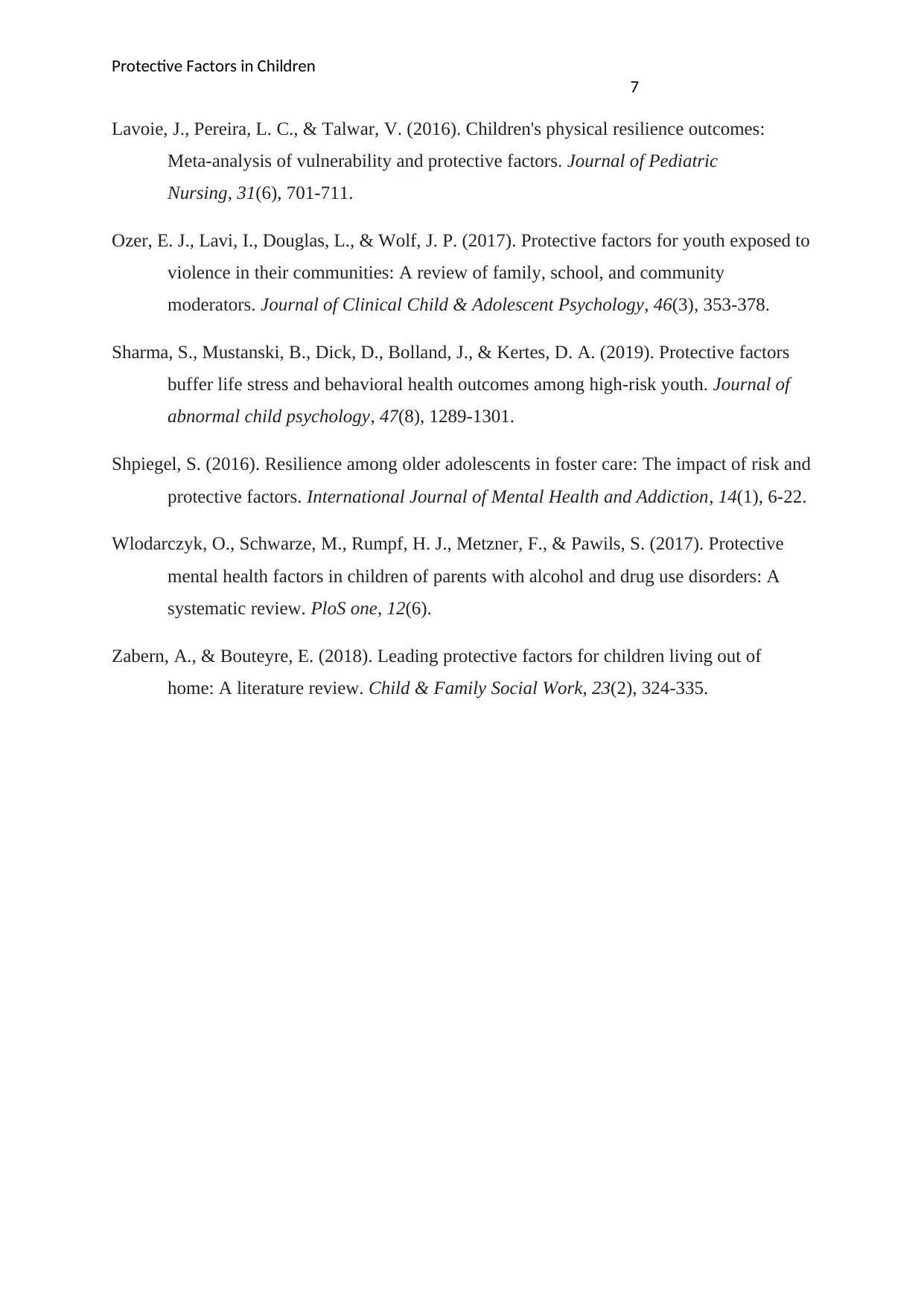
Protective Factors in Children
7
Lavoie, J., Pereira, L. C., & Talwar, V. (2016). Children's physical resilience outcomes:
Meta-analysis of vulnerability and protective factors. Journal of Pediatric
Nursing, 31(6), 701-711.
Ozer, E. J., Lavi, I., Douglas, L., & Wolf, J. P. (2017). Protective factors for youth exposed to
violence in their communities: A review of family, school, and community
moderators. Journal of Clinical Child & Adolescent Psychology, 46(3), 353-378.
Sharma, S., Mustanski, B., Dick, D., Bolland, J., & Kertes, D. A. (2019). Protective factors
buffer life stress and behavioral health outcomes among high-risk youth. Journal of
abnormal child psychology, 47(8), 1289-1301.
Shpiegel, S. (2016). Resilience among older adolescents in foster care: The impact of risk and
protective factors. International Journal of Mental Health and Addiction, 14(1), 6-22.
Wlodarczyk, O., Schwarze, M., Rumpf, H. J., Metzner, F., & Pawils, S. (2017). Protective
mental health factors in children of parents with alcohol and drug use disorders: A
systematic review. PloS one, 12(6).
Zabern, A., & Bouteyre, E. (2018). Leading protective factors for children living out of
home: A literature review. Child & Family Social Work, 23(2), 324-335.
7
Lavoie, J., Pereira, L. C., & Talwar, V. (2016). Children's physical resilience outcomes:
Meta-analysis of vulnerability and protective factors. Journal of Pediatric
Nursing, 31(6), 701-711.
Ozer, E. J., Lavi, I., Douglas, L., & Wolf, J. P. (2017). Protective factors for youth exposed to
violence in their communities: A review of family, school, and community
moderators. Journal of Clinical Child & Adolescent Psychology, 46(3), 353-378.
Sharma, S., Mustanski, B., Dick, D., Bolland, J., & Kertes, D. A. (2019). Protective factors
buffer life stress and behavioral health outcomes among high-risk youth. Journal of
abnormal child psychology, 47(8), 1289-1301.
Shpiegel, S. (2016). Resilience among older adolescents in foster care: The impact of risk and
protective factors. International Journal of Mental Health and Addiction, 14(1), 6-22.
Wlodarczyk, O., Schwarze, M., Rumpf, H. J., Metzner, F., & Pawils, S. (2017). Protective
mental health factors in children of parents with alcohol and drug use disorders: A
systematic review. PloS one, 12(6).
Zabern, A., & Bouteyre, E. (2018). Leading protective factors for children living out of
home: A literature review. Child & Family Social Work, 23(2), 324-335.
1 out of 8
Related Documents
Your All-in-One AI-Powered Toolkit for Academic Success.
+13062052269
info@desklib.com
Available 24*7 on WhatsApp / Email
![[object Object]](/_next/static/media/star-bottom.7253800d.svg)
Unlock your academic potential
Copyright © 2020–2025 A2Z Services. All Rights Reserved. Developed and managed by ZUCOL.





